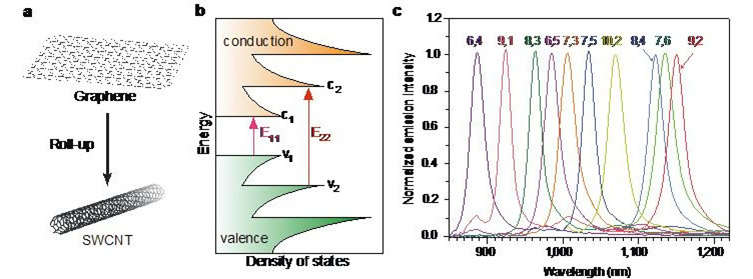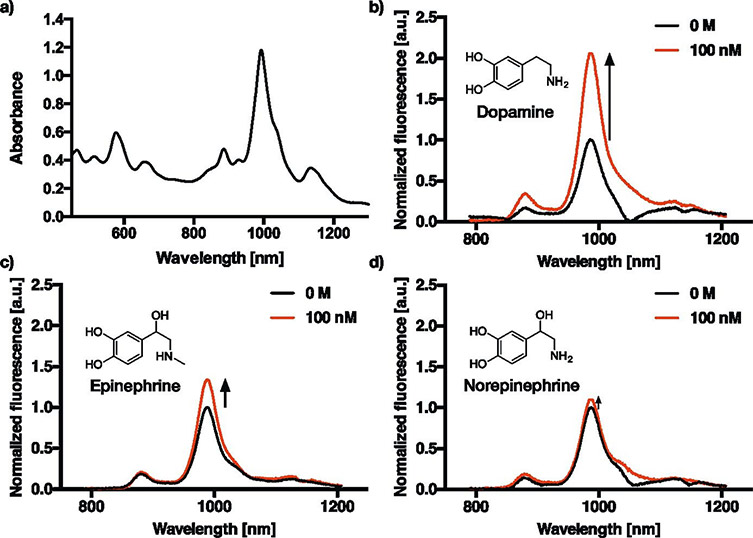Resources
 Part of the Oxford Instruments Group
Part of the Oxford Instruments Group
Expand
Collapse
 Part of the Oxford Instruments Group
Part of the Oxford Instruments Group
Nanostructured carbon nanomaterials have gained a lot of interest since last years, particularly the unique optoelectronic properties of single-walled carbon nanotubes (SWCNTs) such as their excitonic fluorescence (see Figure 1) in the near-infrared (NIR) region have attracted a lot of interest. These properties make SWCNT versatile building blocks for applications in biosensing, imaging and even drug delivery or photodynamic therapy. [1]
We are interested in using SWCNTs as near-infrared optical sensors to detect biomolecules. [1-3] These sensors are powerful tools e.g. to image release of neurotransmitters from cells. [4] To use these highly hydrophobic nanomaterials for the sensing of (bio) molecules, the functionalization of their surface is crucial. [5]
This is commonly achieved via ultrasonic “wrapping” with small synthetic DNA sequences. Recently, we also showed, that it is possible to use barrel-forming peptides to achieve a colloidal aqueous solution of SWCNTs. [6]

Figure 1: (a) Single-walled carbon nanotubes (SWCNT) can be considered as rolled up sheets of graphene. (b) Density of electronic states diagram of semiconducting SWCNTs and transitions E11 and E22 between van-Hove singularities leading to different absorbance and fluorescence spectra depending on the chiral index (m,n). (c) NIR fluorescence spectra of SWCNTs of different chirality (n,m) [1],[2].
To characterize these functionalized SWCNTs, we routinely employ near-infrared (NIR) fluorescence spectroscopy using the Kymera-193i-B2 spectrograph equipped with an iDus InGaAs DU491A-1.7 NIR detector array. The samples are excited with a Cobolt 561 nm laser.
Figure 2 shows the absorption and fluorescence spectra of DNA-wrapped carbon nanotubes. In this particular study, we tested the sensing capabilities of these special SWCNT-DNA conjugates for the neurotransmitter dopamine and the competitive selectivity for its structural analogues epinephrine and norepinephrine.

Figure 2, Absorbance and fluorescence spectra of DNA-wrapped SWCNTs. (a) vis-nIR absorbance spectrum of DNA-wrapped SWCNTs. (b,c,d) nIRfluorescence spectra of (GT)10 functionalized SWCNTs excited at 560nm before and after the addition of 100 nM dopamine (b), epinephrine (c) and norepinephrine (d).[7]
The spectra in the range between 800 nm – 1200 nm clearly show that the (GT)10 DNA sequence leads to a high fluorescence increase for dopamine, whereas (nor-)epinephrine only induces a slight increase. Thus, these sensors can be used for the detection of dopamine in the presence of equimolar amounts of epinephrine or norepinephrine. [4]
We successfully used the Kymera-193i spectrograph and the iDus InGaAs 491 NIR detector to acquire NIR fluorescence spectra of functionalized carbon nanotubes. [5-8] They act as sensors for biomolecules and we quantified quantum yield changes after the addition of neurotransmitters. These findings lead to a better understanding of carbon nanotube photophysics and sensors of high selectivity/sensitivity for promising biomedical applications.
Date: July 2020
Author: F. Mann, S. Kruss, Institute of Physical Chemistry, Göttingen University
Category: Application Note
